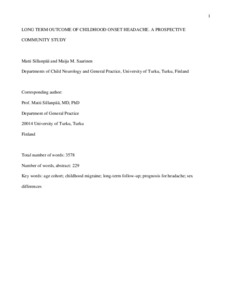Long term outcome of childhood onset headache: A prospective community study
Sillanpää M; Saarinen MM
Long term outcome of childhood onset headache: A prospective community study
Sillanpää M
Saarinen MM
SAGE PUBLICATIONS LTD
Julkaisun pysyvä osoite on:
https://urn.fi/URN:NBN:fi-fe2021042719206
https://urn.fi/URN:NBN:fi-fe2021042719206
Tiivistelmä
Purpose To examine prevalence, course, and long-term outcome of childhood migraine and other headaches.Method Using questionnaires, 1185 children were followed for recurrent headaches at ages seven, 14 and 32 years, respectively.Results At age seven years, 4.0% of the 1185 children (girls 3.7%, boys 4.3%) had migraine and 24% (25%/23%) had nonmigrainous headache. In adulthood, 16% (22%/8%) had migraine and 60% (64%/54%) nonmigrainous headache. Childhood migraine persisted into adulthood in 65% of females and 21% of males, and nonmigrainous headache in 62% and 59%, respectively. After childhood, 17% of females and 7% of males started to have episodes of migraine. No recurrent headache during the follow-up was reported by 11% (6%/16%). In a multivariate analysis, compared with no childhood headache, childhood migraine increased the risk of adulthood migraine by 3.36-fold (95% CI 1.94-5.82) and that of nonmigrainous headache by 1.72-fold (1.14-2.60).Discussion and conclusions Headaches are generally as common in preschool girls as boys. From early school years, headaches steadily increase up to young adulthood, but among boys the prevalence levels off after adolescence. About two thirds of children experienced changes in their headache status during a 25-year follow-up. Any kind of recurrent headache at school entry predicts an increased risk of headache in young adulthood. Special attention should be paid to girls and particularly those girls who have recurrent headache when they start school.
Kokoelmat
- Rinnakkaistallenteet [19207]
